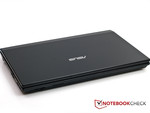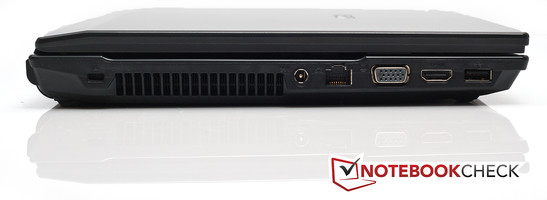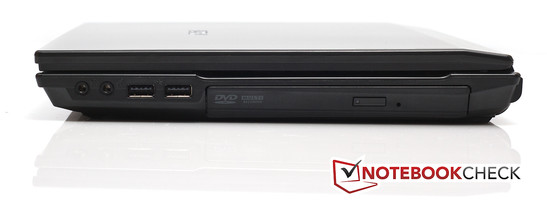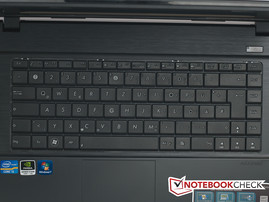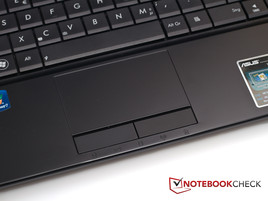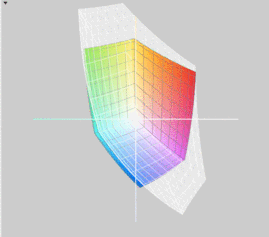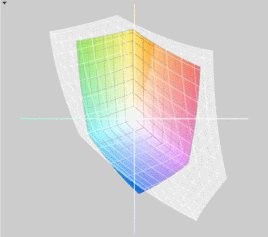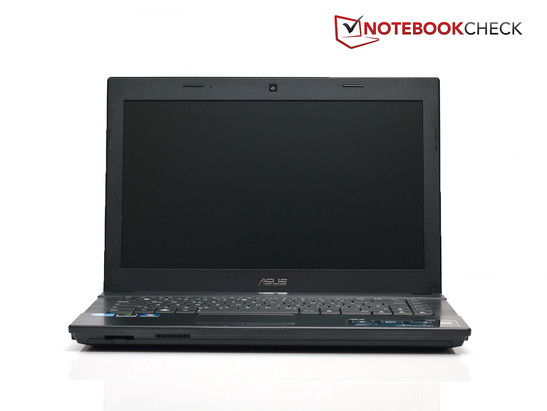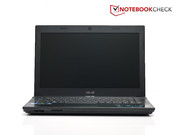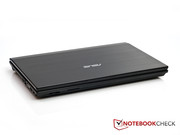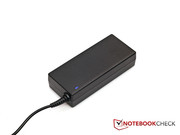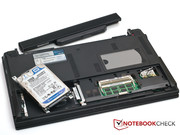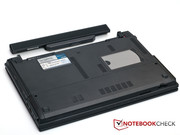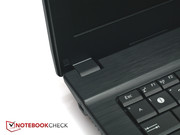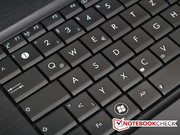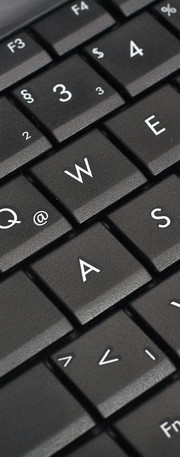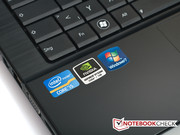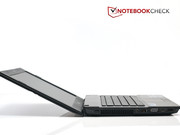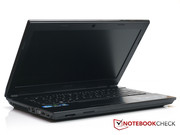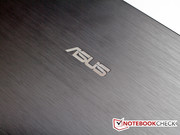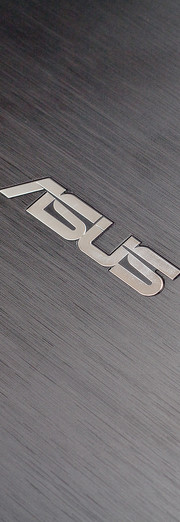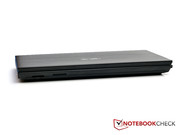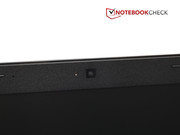Review Asus P43SJ-VO006X Notebook

We had the predecessor of the Asus P43SJ laptop, the Asus P42JC, in review a while ago. Even then, the notebook was able to make a good impression.
A few modifications have been made in the new version of the notebook. The hardware has been revised. Thus, Intel's Sandy Bridge processors have now also found their way into the Asus business laptop. Even a new graphics card has been built into the 14 inch case.
We will put the laptop through its paces in the following review, in particular to see to what extent the upgrades affect the new model.
Case
Not much has changed on the Asus P43JC, compared to the P42JC model. The predecessor's looks have been maintained. There are minor deviations in the dimensions, but nothing worth mentioning. Therefore, we would refer to the review of the Asus P42JC in matters of design.
In terms of manufacturing quality, the Asus P43SJ is impressive. The workmanship is very solid all over. Our pressure tests also prove this. No matter where pressure is applied to the base unit, the surfaces don't yield. Even the keyboard doesn't yield under pressure. Only the display could have a higher torsional stiffness and the hinges that are supposed to keep the display in place could have been pulled a bit tighter.
Connectivity
Unfortunately, it can't be said that the P43SJ has an abundant scope of interfaces. As in the P42JC, Asus again makes cutbacks in connectivity and only equips the P43SJ with the most essential ports. Because USB 3.0 was still quite new and not very widespread as the P42JC was launched, it was easy to ignore the omission of this port. In the meantime, USB 3.0 is much more widespread so that at least one USB 3.0 port could be expected in a business laptop. At least Asus has retrofitted the missing microphone socket, which was left out in the Asus P42JC. Nevertheless, the scope of interfaces is sooner disappointing.
We would have also liked to see the interface placement modified. All interfaces are still found in the front area of the notebook's sides. It can quickly get tight particularly when many peripheral devices are connected to the laptop. Thus, a clutter of cables belongs to the Asus P43SJ.
Scope of Delivery
The Asus P43SJ's scope of delivery isn't exactly abundant, but it nevertheless excels the supplies included by other manufacturers. In addition to the usual documentation in regard to warranty and quick start, there is also a DVD with all notebook drivers. The installation is simple, but very time consuming and tedious.
Security
In terms of the notebook's security features, Asus includes LoJack, BIOS Booting User Protection, HDD User Password Protection and Security and Intel Anti-Theft right away. The latter is software that runs unnoticed in the background and regularly sends the notebook's location data to the Absolute Monitoring Center once it's enabled. When the computer is reported stolen, the Absolute Theft Recovery Team intervenes and uses the data sent from the notebook to recover the device. However, a subscription at Absolute Software needed is to take advantage of this service. A one year subscription is available for 39.95€ and a four year subscription costs 79.95€. The Asus P43SJ doesn't have a fingerprint reader, as was the case in the previous version.
Warranty
Asus delivers the P43SJ in connection with a 2 year pick-up & return service.
Input Devices
The same components as in the P42JC are used as keyboard and touchpad. This isn't very surprising because both the keyboard and the touchpad were impressive the last time and could serve with very good results. Therefore, we would refer to the corresponding section in the review of the Asus P42JC.
Display
Asus installs, as appropriate for a business laptop, a matt display into the P43SJ. The display diagonal equals that of the predecessor and not much has changed here either. The resolution of 1366x768 pixels is again on a good standard and ensures that enough content can be displayed on the screen.
| |||||||||||||||||||||||||
Brightness Distribution: 92 %
Center on Battery: 202 cd/m²
Contrast: 147:1 (Black: 1.37 cd/m²)
The screen built into the Asus P43SJ doesn't prove to be exceedingly bright. With an average brightness of 193.3 cd/m2, it is sooner located in an average field. In return, the screen scores with a very even illumination of 92 percent. The fact that the brightness isn't automatically reduced during battery mode is another point that speaks for the Asus laptop. Regrettably, the black value and the contrast are noticed negatively. Solely the black value of 1.37 cd/m2 has turned out quite high and, together with the mediocre brightness, the contrast suffers clearly. Consequently, the contrast is only poor 147:1. Of interest for graphic pros: The screen in the Asus P43SJ doesn't exactly excel in color reproduction either. The sRGB color spectrum can't be rendered completely and the Asus P43SJ is also at a disadvantage in a direct comparison with the Asus P42JC.
Working outdoors shouldn't be a problem for the screen of the Asus P43SJ. Unfortunately, the weather currently doesn't allow any outdoor tests. However, the determined data show a great similarity to the screen in the P42JC. Thus, it can be assumed that both displays will act similarly in direct sunlight.
The poor screen again becomes obvious in the viewing angles. The picture falsifies quite fast. When several persons are sitting in front of the laptop, or if this is planned, it should be aligned so that everyone is looking at the screen from the front as far as that is possible.
Performance
The processor, an Intel Core i5-2410M, is a midrange dual core processor based on Sandy Bridge architecture. The processor standardly provides a good measure of power with 2.3 GHz. But should it get tight on occasion, the processor can be overclocked dynamically to 2.6 GHz or even 2.9 GHz thanks to Turbo Boost. This is determined by how many cores are loaded and if the processor is sufficiently cooled. Thanks to the Sandy Bridge architecture, the i5-2410M is on about the same level as the Core i5-520M (2.4-2.9 GHz) in our benchmarks. The TDP of 35 watts corresponds to most other Sandy Bridge processors. The processor is recommended for use in 14 inch or larger notebooks.
The installed Nvidia GeForce GT 520M is an entry level graphics card for notebooks. The card's performance level is a bit higher than the Intel HD Graphics 3000 cards. The graphics card is primarily conceived for office tasks on the laptop or surfing on the Internet and is capable of expanding the workload of the integrated Intel GPU thanks to a number of features. Games with high requirements can usually only be rendered in a low detail level and/or resolution. The model built into the Asus P43SJ only has a DDR3 memory. There should also be models with DDR5 memory, but these are the exception because a DDR5 memory lets the graphics card price skyrocket.
In return, the graphics card can score in power consumption compared to stronger models. But it consumes more than solutions incorporated directly into the processor. Theoretically, the Asus P43SJ could also have the Nvidia Optimus Technology. Unfortunately, it's not enabled in our test device so that the user consequently looses a bit of battery runtime.
In order to assess the installed processor's performance, we use the program Cinebench in various versions. The Asus P43SJ achieves a score of 4510 points in the first benchmark, the Cinebench R10 Single Rendering (64 bit) benchmark. The P43SJ is sooner located in the lower third compared with other laptops that have the same processor model. A similar picture is seen in the next test, the Cinebench R10 Multi Rendering (64 bit). The laptop scores slightly better with 9568 points here, but is still in the lower midfield. The Turbo Boost feature works flawlessly. It would first seem likely that Turbo Boost isn't working properly when the performance in the single test isn't good. However this was not the case here (up to 2.9 GHz with one core loaded).
In comparison to the predecessor, the laptop can nevertheless clearly record a higher score. The Asus P42JC reached 3561 points in Cinebench R10 Single Rendering (64 bit) and 7964 points in Cinebench R10 Multi Rendering (64 bit).
We determine the Asus P43SJ's system performance with the programs PCMark Vantage and PCMark 7. The Asus P43SJ achieves a score of 5452 points in PCMark Vantage. The prior model reached a score of 4115 points here. The Lenovo ThinkPad Edge E320 (2310M, Intel HD 3000) is in the immediate vicinity of the Asus laptop with 5427 points. Despite the weaker processor (i5-2310M) and inferior graphics card (Intel HD Graphics 3000) the Lenovo notebook has a slight lead. The fast hard disk in the Lenovo notebook will likely have gained a bit of ground here. Overall, the Asus P43SJ notebook is roughly in the center of our benchmark chart. The Asus notebook scores a bit worse with 1699 points in the somewhat newer PCMark 7 benchmark. Again, it is clearly shown that notebooks with a 2410M processor are usually superior to the Asus notebook.
| PCMark Vantage Result | 5452 points | |
| PCMark 7 Score | 1699 points | |
Help | ||
We use 3DMark06 to assess the graphics performance. The Asus P43SJ, with an Nvidia GeForce GT 520M graphics card, manages a score of 5353 points. Again, the predecessor model, P42JC, is used for comparison reasons. The P42JC with an Nvidia GeForce 310M graphics card (including the Intel HD Graphics via Optimus) reaches a score of 3001 points in 3DMark06. There is a surprise in the comparison with other notebooks that use a GT 520M. While the processor was usually slower than in other notebooks, the installed Nvidia GeForce GT 520M is the fastest among the GT 520M cards in our benchmark chart until now. The second fastest GT 520M card in our chart was installed in an Asus U30SD-XA1 (2410, GT 520M) and achieved 4754 points.
| 3DMark 03 Standard | 11351 points | |
| 3DMark 05 Standard | 9038 points | |
| 3DMark 06 Standard Score | 5353 points | |
| 3DMark Vantage P Result | 2342 points | |
Help | ||
The built-in Western Digital hard disk could not excel in our test. The hard disk is a 2.5 inch model with a (gross) capacity of 320 GB and 5400 revolutions per minute. The WD3200BPVT-80ZEST0 only managed an average transfer rate of 66.9 MB/s in the HDTune benchmark. The access time is still an acceptable 19.8 milliseconds. The P43SJ could benefit from a faster HDD model in the system benchmarks, for example.
Gaming Verdict
As in the predecessor model, we used the real time strategy game StarCraft 2: Wings of Liberty for the gaming tests. Here it becomes very obvious that the Nvidia GeForce GT 520M has a bit more power than an Intel HD Graphics 3000, but is nevertheless not strong enough to play games in the highest details and resolutions.
While everything still worked perfectly in the lowest level with 113 fps (the P42JC with a GeForce 310M managed 77 fps here), it starts to stutter in the higher levels. The graphics card just manages 24 fps in medium settings and stuttering is already noticed (the P42JC only reached 15 fps here). Stuttering is very evident in the highest settings. The frame rate sinks to 19 fps here (the P42JC reached 10 fps). In comparison: Intel's HD Graphics 3000 reaches 13.0 fps in Toshiba's L755-14P (i5-2410M) in high graphic settings, for example.
| low | med. | high | ultra | |
|---|---|---|---|---|
| StarCraft 2 (2010) | 113 | 24 | 19 |
Emissions
System Noise
The Asus P43SJ proves to be a rather quiet work laptop most of the time. The laptop's noise level is 31.5 dB (A) - 32.1 dB (A) in idle and low load. The fan always runs, but is only audible with a very quiet noise. The noise level increases when the laptop is loaded. Nevertheless, the notebook isn't very obtrusive, which is shown by the average rate of 33.1 dB (A). The notebook only gets very audible in maximum load with 40.8 dB (A). DVD playback attracts attention with a noise level of 33.7 dB (A) and will, if at all, only get annoying during quiet movie scenes.
Noise level
| Idle |
| 31.5 / 31.5 / 32.1 dB(A) |
| HDD |
| 32.8 dB(A) |
| DVD |
| 33.7 / dB(A) |
| Load |
| 33.1 / 40.8 dB(A) |
 | ||
30 dB silent 40 dB(A) audible 50 dB(A) loud |
||
min: | ||
Temperature
The Asus P43SJ usually stays cool. The notebook reaches a maximum temperature of 30.7 degrees Celsius on the top when idling. The wrist rest reaches temperatures of 26 degrees Celsius (left) and 28.2 degrees Celsius (right) and thus stays pleasantly cool. The touchpad is also hardly worth mentioning with a temperature of 29 degrees Celsius. The bottom's maximum temperature is also below the 30 degree mark with 29.3 degrees.
The temperatures rise during load, but they are all still harmless. The top's maximum temperature only increases by 5 degrees Celsius to 35.6 degrees Celsius. The wrist rest also only get slightly warmer. The temperatures are now 29.7 degrees Celsius (left) and 28 degrees Celsius (right). The Ice Cool Technology that Asus builds into the wrist rest seems to do its job very well. The touchpad heats up to 32 degrees Celsius. The maximum temperature on the bottom increases to 36.5 degrees Celsius and is therefore just lukewarm. Using the notebook on the lap is thus no problem. Even full load doesn't give reason to worry, whereas lap top use during full load will likely be the exception.
The notebook proves to be as harmless as before during full load. To load the notebook as much as possible, we use the programs Prime95 and FurMark. But even the simultaneous use of both programs didn't bother the Asus notebook much. The processor temperature never surpassed the 85 degree Celsius mark and the GPU temperature didn't go beyond 71 degrees Celsius either. The rates were recorded with the software, PC Wizard. The subsequent benchmark with 3DMark06 delivers an almost identical result as the benchmark test in a "cold" state.
(+) The maximum temperature on the upper side is 35.6 °C / 96 F, compared to the average of 34.3 °C / 94 F, ranging from 21.2 to 62.5 °C for the class Office.
(+) The bottom heats up to a maximum of 36.5 °C / 98 F, compared to the average of 36.8 °C / 98 F
(+) In idle usage, the average temperature for the upper side is 27.4 °C / 81 F, compared to the device average of 29.5 °C / 85 F.
(+) The palmrests and touchpad are reaching skin temperature as a maximum (32 °C / 89.6 F) and are therefore not hot.
(-) The average temperature of the palmrest area of similar devices was 27.6 °C / 81.7 F (-4.4 °C / -7.9 F).
Speakers
As in the P42JC, the small speakers again come from Altec Lansing. Unfortunately, the sound quality of the P43SJ is just as unconvincing as it was in the P42JC. The maximum volume isn't particularly high and, as regrettably common for notebook speakers, the basses don't exist at all.
Battery Life
Long battery runtimes in a notebook are an important selections criterion for many users. Low power consumption is compulsory in order to achieve this. But the power consumption already indicates that the Asus P43SJ won't be an enduring companion. The notebook consumes 15.0 watts - 18.1 watts only in idle mode. This can likely also be ascribed to the permanently active Nvidia GeForce graphics card. The power consumption increases to 47.0 watts - 78.1 watts during load. The included 90 watt adapter can easily cope with this power requirement.
| Off / Standby | |
| Idle | |
| Load |
|
Key:
min: | |
As the consumption rates already indicated, the battery life isn't one of the laptop's strengths. The BatteryEater Pro software was used for testing. The Asus P43SJ just manages a battery runtime of 3 hours and 49 minutes in the Reader's Test (idle). The rate from surfing on the Internet should be a bit closer to reality. The notebook manages a battery runtime of nearly 3 hours. When the P43SJ is loaded even more in battery mode, the runtime sinks to 1 hour and 32 minutes.
Verdict
The successor model of the P42JC notebook leaves us with mixed feelings. On the one hand, we would have appreciated more far-reaching upgrades in some areas. On the other, the notebook was convincing in other things, anyway. The scanty connectivity is still noticed adversely. It would have been time for USB 3.0 with the update. And the new screen can't completely convince us either. The low contrast is annoying although the user can benefit from the ergonomically matt and non-glare surface.
Of course, the upgrade has its advantages. The new processor in the notebook supplies a healthy measure of (more) power and the new graphics card also is noticed in many areas. But unfortunately, the omitted Nvidia Optimus feature is noticed too. We also have to mention that the used graphics card is currently the fastest GeForce GT 520M in our database. We find the continued use of the very attractive design and the good input devices inherited from the predecessor agreeable.
With the P43SJ, Asus brings a strong notebook with office alignment and elegant looks to the customer. However, it's not completely exempt from single weak points.




